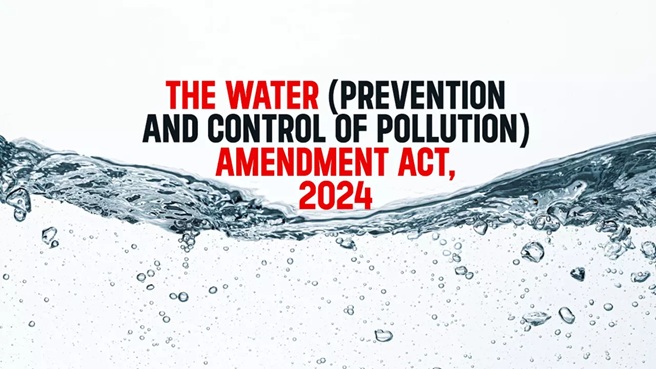Water pollution is a serious environmental challenge in India. Rivers, lakes, and groundwater are increasingly burdened with industrial waste, domestic sewage, and chemical contaminants. To address this, the Water (Prevention and Control of Pollution) Act, 1974 was enacted.
In 2024, a major Amendment Act was introduced with the objective of making the water pollution control framework more practical, effective, and aligned with the “Ease of Doing Business” initiative.

Background
(a) The Original Act – 1974
- The Act was passed by Parliament under Article 252 of the Constitution.
- Objective: To prevent and control water pollution and to maintain or restore the wholesomeness of water.
- It established:
- Central Pollution Control Board (CPCB)
- State Pollution Control Boards (SPCBs)
- Industrial units were required to obtain consent before discharging any effluents into water bodies.
- Violations were punishable with imprisonment and fines.
(b) Need for Amendment
- Over the past five decades, industrial structures, environmental challenges, and technologies have changed significantly.
- Even minor technical lapses or delays in reporting could earlier result in criminal prosecution.
- This neither ensured effective prevention nor encouraged investment.
- Many SPCBs suffered from inadequate manpower and technical capabilities.
- Hence, the 2024 Amendment Act was introduced to make the system more efficient and compliance-oriented rather than punishment-driven.
Key Provisions
(1) Territorial Application
- The amended Act was immediately applicable to Himachal Pradesh, Rajasthan, and Union Territories.
- Other states can adopt it by passing a resolution under Article 252.
- Example: Bihar adopted the Act in April 2025.
(2) Empowerment of the Central Government
- A new Section 27A was inserted: The Central Government, in consultation with the CPCB, may issue guidelines to State Boards regarding the consent-granting process.
- This ensures uniformity of standards across the country.
(3) Major Changes in Penalty Provisions (Decriminalisation)
- Earlier, several violations attracted imprisonment.
- Now, most technical or first-time offences have been converted into monetary penalties.
- Penalty Range:
- ₹10,000 to ₹15 lakh
- Higher fines for repeat offences.
- Aim: “Encouragement of compliance rather than punishment.”
(4) Exemptions for Industrial Units
- The Central Government can exempt low-risk industries from obtaining prior consent.
- Such categories will be determined in consultation with CPCB.
- Expected outcome: Improvement in Ease of Doing Business.
(5) New Rules for Penalty Determination
- The Water (Prevention and Control of Pollution) (Penalty Determination Process) Rules, 2024 have been notified.
- They outline the procedure for inquiry, hearing, and penalty imposition.
- Aim: To make the process speedy and transparent.
Significance of the Act
(1) Step Towards Governance Reform
- Decriminalisation will reduce the burden on courts.
- Fine-based penalties enable quicker resolution.
(2) Improvement in Business Environment
- Eliminates the fear of imprisonment for minor violations, benefiting industries.
- Supports Ease of Doing Business and Make in India.
(3) Uniform Environmental Regulation
- Central guidelines will promote uniform standards and policy clarity across states.
(4) Public Welfare and Water Quality
- Better compliance will improve the quality of rivers and lakes, enhancing public health.
Issues & Challenges
(1) Reduced Deterrence
- Experts argue that a fine-based system may weaken the deterrent effect.
- If fines are too low compared to industrial profits, violations may be seen as a “cost of doing business.”
(2) Weakening of States’ Role
- Water is a State List subject (Entry 17, List II).
- Greater central control could raise federal concerns.
(3) Capacity Constraints of States
- Many SPCBs lack adequate laboratories, technical staff, and equipment.
(4) Implementation Gaps
- The law’s success depends on effective ground-level monitoring, data-sharing, and transparency.
(5) Risk in Exemption Policy
- If “low-risk industries” are defined too liberally, the overall pollution load may increase.
Way Forward
|
Area
|
Recommendation
|
|
Institutional Capacity
|
Equip CPCB and SPCBs with modern technologies (IoT-based sensors, GIS monitoring) and adequate staff.
|
|
Transparency
|
Make all approvals, exemptions, and penalty data publicly available on an online portal.
|
|
Penalty System
|
Impose significantly higher fines for repeat offences.
|
|
Community Participation
|
Involve local communities, NGOs, and citizens in monitoring processes.
|
|
State Coordination
|
Encourage all states to adopt the amended Act promptly.
|
|
Periodic Review
|
Evaluate the impact of this amendment every 2–3 years.
|
Conclusion
“This Act is not merely a legislative amendment, but a shift in the philosophy of environmental governance.”
The Water (Prevention and Control of Pollution) Amendment Act, 2024 symbolizes the modernization of India’s environmental policy framework. It transitions from a criminal penalty-based approach to an administrative fine-based system, aiming to balance environmental protection with economic development.
The law’s success will depend on:
- Strong Centre-State cooperation,
- Fair and transparent enforcement, and
- Active public participation.



